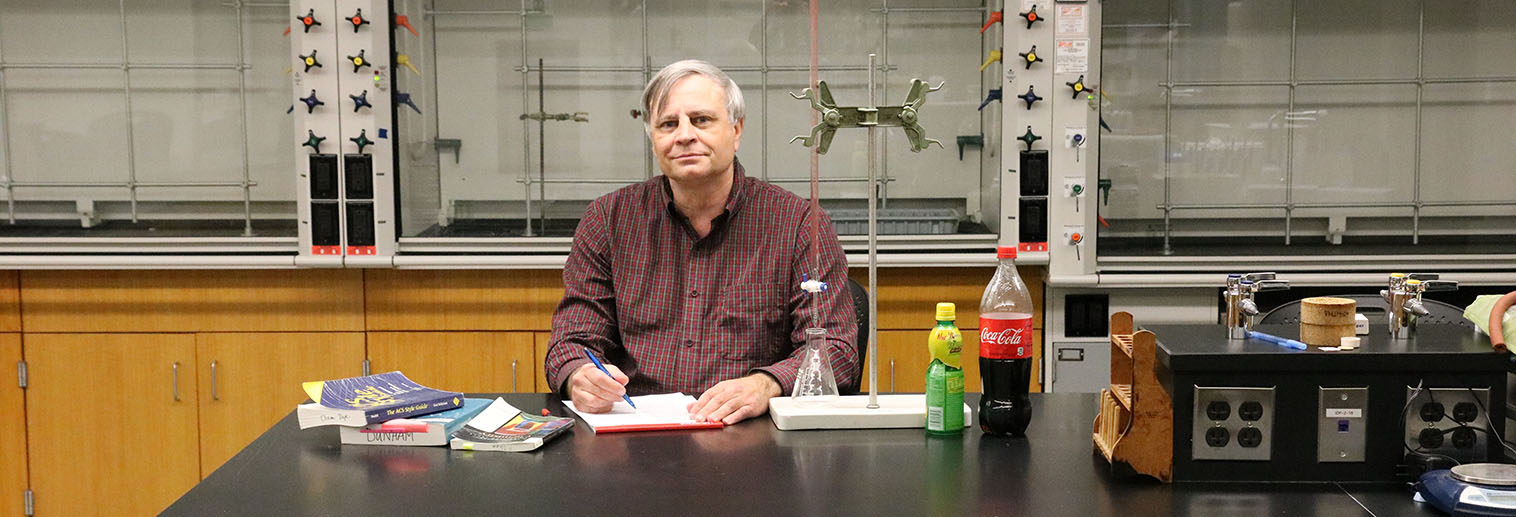Who is Aunt Gladys?
by Carl Salter, Department Chair and Professor
Eavesdrop on a conversation among Moravian chemistry graduates, and you’ll probably hear the names of many chemistry professors, past and present. But you will probably also hear a name that makes everyone in the group nod silently and smile. For the most recent generation of chemistry majors, “Aunt Gladys” is just as important a name as Kulp, Martin, or Libby. So just who is Aunt Gladys, and what does she do for Moravian’s chemistry program?
To be honest, Aunt Gladys is a pedagogical device. She is a character created by Mark Ritter, a high school teacher in California. In 1988 Ritter published a paper in the Journal of Chemical Education titled “Bringing Science to the People.” Within the paper is the final portion of a letter from Aunt Gladys that is addressed to the students in Ritter’s class. Here is Aunt Gladys’s letter:
... and so Uncle Wilbur’s foot is better now. Anyway, honey, I do hope things are well with you. I’ve heard such wonderful things about you since you went off to school. Which reminds me! Your uncle and I were sitting out front last Tuesday, just like regular, and I got to thinking about something that was bothering me. What I would like to know is … [insert your question here]. Now, remember, honey, I’m getting along in years and I ain’t had the decent education that you’re getting. So when you write back you make sure to explain it in a way us regular folk can understand. Give my love to all.
Love and kisses,
Aunt Gladys and Uncle Wilbur
Ritter listed some questions that Aunt Gladys asks, such as “What makes Scotch tape stick?” and “Why do people wash with lemon juice after handling fish?” The primary objective of the assignment is “to explain in a simple and understandable way a common everyday question someone might have which involves chemistry.” He reported that his students were very proud of solving the little mystery and explaining it in a way that Aunt Gladys and fellow students would understand.
I remember reading Ritter’s paper not long after I started teaching at Moravian. I was teaching Chemistry 100, the course called “Chemistry & Society” designed for nonscience majors, and I realized that the Aunt Gladys letter was a perfect way to make students discover the relevance of chemistry in their everyday lives. What I didn’t realize until much later was that our chemistry majors needed to discover that relevance as well. So when “Methods of Chemical Research” was introduced, and became the Writing Intensive Course in the chemistry major, Aunt Gladys found her place in the chemistry program at Moravian University.
Over the years the questions have become a bit more complicated. Mail Merge in Word allows each student to receive personalized letters from Aunt Gladys. And in the Research Methods class there isn’t just one Aunt Gladys letter—students get three or four letters from Aunt Gladys, and even do experiments based on some of her questions!
And now Aunt Gladys has some friends who help inspire her curiosity. Birdie Knestor is a wonderful cook, and often shares recipes with Aunt Gladys, but she and Gladys often have questions about food and cooking. “How do they make butter and margarine look the same?” “Is the hot stuff in green peppers and black pepper the same?” “What’s the difference between baking soda and baking powder, and why does that matter in Birdie’s cookies?”
And then there’s Mabel Sirrup, the science teacher at nearby Possum Ridge High School, who chats over coffee with Gladys and Birdie. Birdie wanted to know if she could change a baking recipe, making a switch from lemon juice to cherry cola, and Mabel said that the amount of acid might be different. So every student in Research Methods gets a letter from Aunt Gladys asking about the acids in lemon juice and cola, and the class responds by doing an experiment to measure the acid content of both liquids. The students send back a letter to Aunt Gladys with an explanation about acids in juices and sodas written for Gladys and Birdie, and the letter also contains a special appendix to explain the experimental details to Mabel.
Time is set aside on the last day of Research Methods to read aloud some of the Aunt Gladys letters, so it’s not surprising that, with all the communication back and forth between chemistry students and Aunt Gladys, she and Uncle Wilbur make a pretty big impression on our majors. Lisa Morkowchuk (Ph. D. Rensselaer) showed up on the last class day wearing a blue and white gingham dress, in homage to her “aunt”. Another student, Pete Slivka (Ph. D. Colorado) repeatedly told Aunt Gladys to stop writing to him because he was very busy with his Honors project—and Pete’s letters included some rather nasty comments about Uncle Wilbur’s clumsiness around the farm. (Note the reference to a foot injury above!)
But the students also realize the importance of learning to write about chemistry, and to write to a variety of audiences. Elias Hasenecz, who graduated two years ago and is doing graduate work in chemistry at Iowa, wrote this:
I still remember my Aunt Gladys letter-- I wrote about Limonene. The fact that that little assignment stuck with me all this time is a testament to how unique and useful the assignment and the class was in getting me to think about science communication. Not only that, it is really important and lacking in many undergraduate settings. There is a big push here in the chemistry department, which is following a larger trend at many universities, to improve grad student's scientific communication skills.
That’s a fitting tribute. I sure hope Aunt Gladys stays around the Moravian chemistry department for quite a while.

